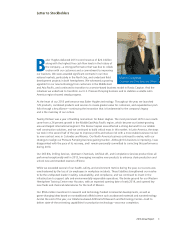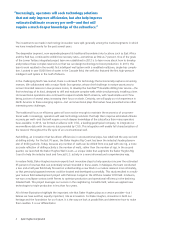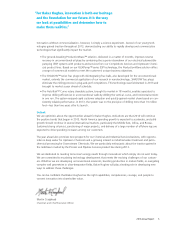Baker Hughes 2013 Annual Report Download - page 18
Download and view the complete annual report
Please find page 18 of the 2013 Baker Hughes annual report below. You can navigate through the pages in the report by either clicking on the pages listed below, or by using the keyword search tool below to find specific information within the annual report.
The fl awless performance in the Vaca Muerta was
the result of close collaboration between Baker
Hughes and the operator. Customer personnel were
immersed in our completion and pressure pumping
technologies at our Center for Technology Innovation
in Houston and at our pressure pumping technology
facility in Tomball, Texas. Engineers from our Argen-
tina team were trained in Oklahoma City, Oklahoma
and Odessa, Texas, and the project was executed
with help from fi eld personnel from Mexico. The
North America operations team supported the
operation with engineering and equipment.
Boosting Production Offshore Brazil
Approximately one-half of the world’s deepwater
producing wells are between 5 and 10 years old and
are reaching the point where intervention is necessary
to rejuvenate production. At the same time, the
reservoirs from which these wells produce are experi-
encing pressure depletion. Powerful ESP-based subsea
boosting is becoming crucial to maximizing ultimate
recovery in deep- and ultra-deepwater fi elds. Baker
Hughes ESPs are key enablers of subsea separation
and boosting of produced fl uids. In Brazil, we
installed the world’s fi rst horizontal subsea skid
system, offshore in 3,930 feet (1200 meters) of water.
The system’s fl awless performance and high produc-
tion rates verifi ed its asset-enhancing value.
” Powerful electrical submersible pump-based
subsea boosting is becoming crucial to maximizing
ultimate recovery in deep- and ultra-deepwater
fi elds, such as Brazil.”
Proving Nanotechnology in the Oilfi eld
The IN-Tallic™ frac balls that contributed to a hydraulic fracturing
record in Argentina’s Vaca Muerta fi eld are composed of a ground-
breaking nanostructured material developed by Baker Hughes. The
material is lighter than aluminum yet stronger than some milled
steels and has unique chemical properties that cause it to disin-
tegrate when exposed to the appropriate fl uid.
IN-Tallic
frac balls
maintain their shape and strength during fracturing, then disinte-
grate at a controlled rate before or shortly after the well is put on
production, so operators can achieve a more effi cient fracturing
operation and unimpeded production without the expense of
removing the balls after a multistage completion.
Tapping the Vaca Muerta Shale
As unconventional resource development moves into
Latin America, our reservoir expertise, well construc-
tion services and project management capabilities are
in demand. Last November, we completed the fi rst
FracPoint™ multistage completion in South America,
performing fl awlessly to tap the Vaca Muerta shale
play in Argentina. Using our IN-Tallic™ disintegrating
frac balls, we set a record by hydraulically fracturing
four of seven stages in one day.
132013 Annual Report
























